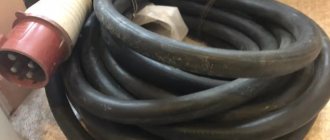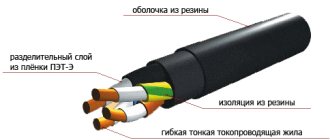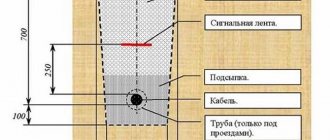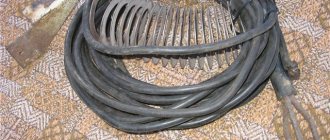Cable KG stands for:
- K - Cable
- G - Flexible
On the websites of cable companies that produce these products, the main attention is paid to the main technical characteristics: the number and cross-section of cores, rated current, diameter, weight, etc.
Main technical characteristics of the KG cable
Permissible load current, weight, outer diameter
We will consider several other issues that play an equally important role when choosing this product.
1Where should the KG cable not be connected? 2Is there a cable that is even more flexible? 3Why is the copper wire dark in color? 4Why is a specialized cable “evil” for home use? 5Why does CL have such a short service life?
Having initially lost sight of all this, your cable will “short” very quickly, and you won’t even understand why this happened and you will blame it all on poor-quality material or the manufacturer, which in the end will have nothing to do with it.
Cable or wire
There are so many jacketed cables and wires on the market these days that many people still confuse the concepts of cable and wire. Someone claims that cables are those products that can be laid in the ground.
Others argue that a cable refers to all wires that have another outer sheath. Although the very first cable in the world did not have a sheath at all, it was still considered a cable.
Later, the veins began to be insulated with gutta-percha, a natural material made from tree sap. At the same time, this insulation also had to be maintained in a damp state.
Therefore, you cannot judge by appearance alone whether this is a cable or wire. A striking example of this is the ShVVP cord or PVS wire.
This also includes SIP-4, which is mistakenly called SIP cable.
Only the manufacturer of the product, who imparts certain properties to its insulation, labels the product accordingly, and can indicate its functional significance.
Laying methods
Such flexible power cables are not installed permanently. They usually roll out on the ground or hang in the air. Large lengths of cable for moving devices (telphers and talcs, hoists) are hung on cables along which they are fed or collected depending on the direction of movement.
By the way. It is permissible to cover them with temporary covers, lay them in channels and corrugated sleeves or HDPE pipes, but it is unacceptable to lay them in the ground. They are not designed for this.
Cable suspension KG
Flexible power cables will last longer than the period stated by the manufacturer if all the necessary technical conditions for their operation are met. A CG conductor of sufficient cross-section will ensure uninterrupted operation of mobile electrical objects.
Places of application of the KG cable
In theory, the era of rubber insulation is long gone. Everyone is switching en masse to other innovative materials - polymers, XLPE cross-linked polyethylene, etc.
Why is the KG cable still produced and widely used both in everyday life and in industry? Maybe our factories simply don’t want to re-equip and modernize their fleet of machines and equipment, or do they have too many rubber stocks?
Not at all. The answer here is simpler. There is simply no worthy and inexpensive alternative to the KG flexible cable.
Initially, this cable came to us on the “surface” from the mine. Hence its rated alternating voltage - up to 660V.
Rubber casings are always actively used where maximum flexibility is required:
- in mine
- on excavators
- hoists, winches
- in shipbuilding (+ possibility of use at 100% humidity!)
Not only electricians and welders fell in love with KG. Connoisseurs of good and high-quality sound have adapted it to connect acoustics in cars. It is still considered a good alternative to specialized brands Pride 4Ga, etc.
The main advantage of KG is the ability to work in the most difficult production conditions. The cable can be dragged painlessly along the ground for tens of meters, subjected to severe bends and deformations.
No other cable can replace KG in this situation. If it had at least several layers of insulation.
Therefore, remember and secure - the KG is intended primarily for connecting portable electrical installations, and not for stationary and long-term use in electrical panels.
It easily withstands vibrations, small insulation scuffs and even twisting into a loop.
Although, according to the norm, the bending radius is also limited here - 8 outer diameters.
Modifications
There are several models from this category of flexible conductors: KGVV and RKGM. They are designed for specific applications. The KGVV cable has polyvinyl chloride (PVC) insulation in its structure, not rubber. This increases the service life to 25 years. It is used to connect mechanisms operating in quarries: these are excavators, cranes and other large mechanisms that consume alternating and direct current.
Important! KGVV allows the supply of current with a frequency of 50 Hz and a voltage from 660 to 1000 V. The operating voltage range at direct current is from 1000 to 1500 V.
Decoding of KGVV markings
The RKGM modification cable has silicone insulation in its structure. He is not afraid of practically anything except oils and chemically aggressive substances. Temperature range – from -600С to +1800С. Available with core cross-sections from 0.75 to 120 mm2. Used in alternating current networks with a voltage of 0.66 kV and a frequency of 50 Hz.
Explanation of the RKGM designation
Differences between KG and KOG cables
If you need an even more flexible cable, the KOG or KOG-1 brand is at your service. Actually, that’s what it stands for – Extra Flexible Cable.
The copper veins in it are much thinner than in ordinary CG. Hence the increased flexibility. Still, 6th grade instead of 5th.
Many welders choose it for this reason. The KOG-1*16 is placed on the holder (the wrist gets less tired), and the usual KG is placed on the “ground”.
To distinguish one from the other, you need to compare the thickness of the veins with a micrometer. Do not be guided by the plexus of veins in pigtails. Some experts claim that in KG the wires are in a continuous layer, while in KOG they are supposedly braided into separate bundles.
This is wrong. You can only trust the markings or micrometer readings. “Braids” come from one brand or another.
Marking
Usually the abbreviation of the brand of cable products can tell you what kind of product it is, what it consists of and where it can be used. The main letter indices include:
- K – cable;
- G – flexible.
VVG cable - decoding and application
In addition, additional letters and numbers may follow, namely:
- T – tropical climatic version (heat and humidity);
- CL – cold climate with sub-zero temperatures (below -250C);
- N – non-flammable outer coating;
- 1st digit – number of cores (2-5);
- 2nd digit – S cores, mm2.
Attention! The symbol on the surface of the cable includes the plant logo and year of manufacture. Marking is applied along the entire length of the cable every 550 mm.
The conductors are wound on drums or twisted into coils. In this case, the label attached to the winding includes the following data:
- factory sign;
- cable name;
- length, m;
- weight, kg;
- certificate of conformity (if accompanied by a certificate);
- release date.
In the case of a paper label, it must be stamped by the technical control department.
Important! The core insulation is color coded. The “grounding” (green-yellow) and “grounding” (light blue) cores are highlighted in separate colors.
For example, a four-core CG may have the same color marking for three cores, and green-yellow for the fourth. In this case, the cross-section of the grounding conductor is allowed one step lower: KGng 3 * 2.5 + 1 * 1.5, but this is not necessary. Manufacturers produce products in which all four cores have the same cross-section.
Working with cables in winter
Another important point is the ability to work at high negative temperatures. The range even for an ordinary CG is very wide - from -40C to +50C.
Due to this, in winter it can be unhindered and unhindered without damaging the conductors and insulation. Try doing something similar at -25C with VVGng vinyl.
The KG cable remains quite flexible even at -30C. If you live in regions with frosty winters, then pay attention to the KG-hl brand. She has a maximum temperature of up to -60C!
This cable will be an ideal option for connecting gas guns for heating frozen cars in winter.
In everyday life, an ordinary CG is used as a carrier for power tools or when connecting a welding machine. It is more resistant to mechanical stress than PVA wire.
Namely, PVA is most often used in factory extension cords.
Therefore, professional installers prefer to make 220-380V transfers themselves.
Main manufacturers
Cable products of the KG brand from domestic manufacturers are manufactured in accordance with GOST-13497-77. The following factories are noteworthy:
- JSC Elektrokabel Kolchuginsky Plant is recognized as the leading manufacturer of cable products in the Russian Federation.
- KamKabel LLC produces about 40,000 types and types of cables and is among the TOP 10 best manufacturers.
- OJSC RybinskKabel is in 6th position in the top ten.
Products manufactured by Tomsk Cable LLC and other domestic manufacturers are popular.
Brand KG is tested for water resistance and is subjected to short-term maximum loads of alternating current. The goods on sale from the listed manufacturers comply with GOST requirements in all basic parameters, which guarantees their safe operation throughout their entire shelf life.
Specialized brands
In addition to the usual KG or KG-chl, their modification KGE is also produced for industry.
Inside the sheath of such a cable there is a screen made of conductive rubber. If the cable cores are damaged, leakage immediately begins on this screen, followed by protection activation.
By the way, many consumers still for some reason confuse KG with other “mine” brands, for example GRSHE. I remember how miners in Soviet times carried such cables en masse to their homes and “freely” connected their residential buildings with them.
After a couple of years of stationary street operation of the cable, real problems began.
The electricians servicing these 0.4 kV overhead lines then cursed for a long time, trying to find a short circuit on a branched line with dozens of consumers. It seems that there is no overlap of wires, but the machine at the KTP knocks out.
So, in order to find the damage, it was necessary to throw away these “miners” first.
Special shielded grades of KG cable are still used in mines. However, there is no point in using them in everyday life.
Temperature indicators
The main points characterizing the temperature dependence of various cable parameters include:
- maximum permissible operating temperature – 750C;
- temperature range for operation – from – 400С to +500С;
- insulation resistance - its value (50MΩ/km) is measured strictly at T = +200C.
Additional designations indicate the peculiarities of the temperature climate regime. For example, the conductor’s kg chl decoding indicates the permissibility of operation in cold climates.
Interesting. Tests of single-core CG cables require immersing the product in water. When current is passed through it, its maximum heating should be no more than 750C for a working cable.
Dark color of copper cores and cable aging
Another feature of KG is blackened copper conductors. Rubber insulation is to blame here.
It contains various polyvalent metals, as well as sulfur. As the temperature rises (cable under load), sulfur begins to actively interact with copper, causing its oxidation.
That is why the manufacturer places a special separator in the form of a film between the current-carrying copper core and the insulation.
However, according to GOST, such a film is not required for cables with a cross-section of up to 50mm2. Therefore, do not be surprised if it is not included in your product.
If it is present, then this cable is of very good quality and the manufacturer is responsible for its product. PVA wires do not require any separators, since the PVC sheath does not oxidize copper.
By the color of copper you can easily determine which cable you have in front of you, new or used. Even if its shell is like new, but the cores are darkened, we can conclude that the cable was subjected to significant loads or even overload.
When a completely new cable also has a black tint of copper and you really know that it is new, this indicates a violation of the insulation technology.
Well, the new KG smells unbearably of rubber. In the old one, the pungent smell gradually fades away.
Design
This brand of cable is distinguished by the fact that it has rubber insulation. Unlike polyvinyl chloride, rubber is extremely flexible and soft. There are no restrictions on the number of compressions and stretches. It works almost until the moment of self-destruction, which occurs as a result of the natural aging process. And this process can last more than ten years, depending on operating conditions.
The conductor is twisted from thin (sometimes tinned) copper wires. Stranded conductors are covered with rubber insulation. (see Fig. 2)
Figure 2. KG cable structure
The letters indicate:
- A – outer shell;
- B – stranded core:
- C – core insulation.
There may be options in the design of products: depending on the design features, the core insulation may be made of silicone rubber or it may not be present at all in large cross-section single-core cables. A single copper core, or their entire package, can be placed in a thin PET-E synthetic film, used as additional protection for the wires. This entire structure is covered with a rubber shell. Figures 3 and 4 show samples of single-core wires of different designs.
Figure 3. Flexible single-core cable KG of large cross-section
Figure 4. KG cable, which uses film for winding the core
Core markings are color or digital. Light blue identification is used only for grounded line conductor. Yellow-green longitudinal stripes indicate grounding conductors. However, it is not allowed to use these colors to mark the cores separately. Other colors are used in accordance with international standards.
The number of conductive cores ranges from 1 to 5 pieces, with a cross-section from 1 mm2 to 240 mm2. To insulate them, RTI-1 or RTI-2-HL rubber is used. The outer sheath is made of rubber type RShT-2, RShTM-2 or RTISH (used in single-core cables).











